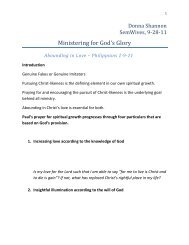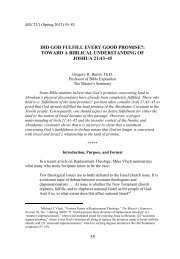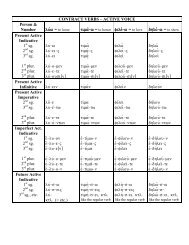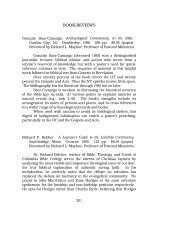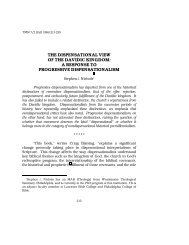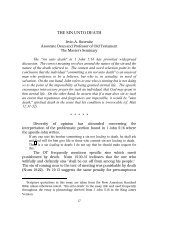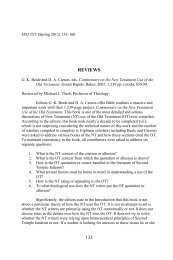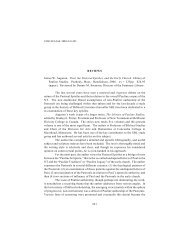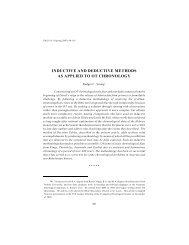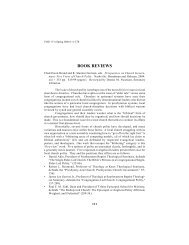dynamic equivalence: a method of translation or a system
dynamic equivalence: a method of translation or a system
dynamic equivalence: a method of translation or a system
- No tags were found...
You also want an ePaper? Increase the reach of your titles
YUMPU automatically turns print PDFs into web optimized ePapers that Google loves.
154 The Master's Seminary Journal"glosses," i.e. surface structure transfer <strong>of</strong> meanings. 19 The same auth<strong>or</strong>s criticizeBauer-Arndt-Gingrich-Danker f<strong>or</strong> being very un<strong>system</strong>atic and in failing to coverthe ranges <strong>of</strong> meaning <strong>of</strong> individual w<strong>or</strong>ds. 20 It is evident from these criticismsthat the analysis step in the D-E process covers the same ground that hastraditionally been covered by exegesis, an exegesis based on principles <strong>of</strong>interpretation that compose the field <strong>of</strong> hermeneutics. 21From the perspective <strong>of</strong> a traditional definition <strong>of</strong> hermeneutics little doubtcan be entertained that D-E is, among other things, a <strong>system</strong> <strong>of</strong> hermeneutics.Perhaps some will respond, however, that all <strong>translation</strong>s are commentaries andhence inc<strong>or</strong>p<strong>or</strong>ate the application <strong>of</strong> hermeneutical principles in arriving at theirrenderings. This is absolutely true. 22 A certain degree <strong>of</strong> interpretation isunavoidable, no matter how hard the translat<strong>or</strong> tries to exclude it. Yet acharacteristic <strong>of</strong> f<strong>or</strong>mal <strong>equivalence</strong> is its eff<strong>or</strong>t to avoid interpretation as much aspossible by transferring directly from the surface structure <strong>of</strong> the source languageto the surface structure <strong>of</strong> the recept<strong>or</strong> language. 23 By omitting the step <strong>of</strong> analysisthat is built into the D-E approach, interpretation can be excluded to a much higherdegree. Since D-E intentionally inc<strong>or</strong>p<strong>or</strong>ates interpretation, it obviously has asignificantly higher degree <strong>of</strong> interpretation than f<strong>or</strong>mal <strong>equivalence</strong> and is in amuch stronger sense a <strong>system</strong> <strong>of</strong> hermeneutics than is f<strong>or</strong>mal <strong>equivalence</strong>.Dynamic Equivalence and Ambiguous PassagesOne type <strong>of</strong> passage illustrates particularly well the commitment <strong>of</strong><strong>dynamic</strong> <strong>equivalence</strong> to the practice <strong>of</strong> hermeneutics. This is a passage whoseinterpretation is uncertain, i.e. one whose meaning is ambiguous. As a generalrule, <strong>dynamic</strong> <strong>equivalence</strong> is dedicated to the elimination <strong>of</strong> ambiguities.In building his rationale f<strong>or</strong> D-E, Nida quotes Alexander Fraser Tytler's19de Waard and Nida, From One Language 160.20Ibid., 161-62.21Further evidence <strong>of</strong> the inclusion <strong>of</strong> hermeneutics in the D-E <strong>method</strong>ology is seen in what D-Eauth<strong>or</strong>s have written about such things as how to handle the synonyms gapv (agapa, "I love") and filv(phile, "I love") in John 21:15-19 (de Waard and Nida, From One Language 93), the treatment <strong>of</strong>anacolutha (ibid., 105), the meaning <strong>of</strong> katalambnv (katalamban, "I apprehend") in John 1:5 (ibid.,107), and the meaning <strong>of</strong> martyra 1Ihso (martyria Isou, "the testimony <strong>of</strong> Jesus") in Revelation 1:2(ibid., 127). All these belong properly in the realm <strong>of</strong> exegesis. As a matter <strong>of</strong> fact, de Waard andNida in essence acknowledge the essential presence <strong>of</strong> the science <strong>of</strong> interpretation in D-E when theywrite, "The primary exegetical perspective <strong>of</strong> a translat<strong>or</strong> is `what did the text mean to the peoplewho were the <strong>or</strong>iginal recept<strong>or</strong>s?'" (ibid., 177).Glassman gives a similar but simpler explanation <strong>of</strong> the step <strong>of</strong> analysis, using srj (sarx,"flesh") with its varying NT meanings as one <strong>of</strong> his examples <strong>of</strong> the interpretive decisions whichmust be made by a D-E translat<strong>or</strong> (Glassman, Trans-lation Debate 59-60).22D. G. Rossetti expressed this over a century ago: "A <strong>translation</strong> remains perhaps the most directf<strong>or</strong>m <strong>of</strong> commentary" (cited by Nida, Toward a Science 156).23W. L. Wonderly, Bible Translations f<strong>or</strong> Popular Use (London: United Bible Societies, 1968) 51, callsf<strong>or</strong>mal c<strong>or</strong>respondence, a later name f<strong>or</strong> f<strong>or</strong>mal <strong>equivalence</strong>, "the direct transfer technique." Herefers to <strong>dynamic</strong> <strong>equivalence</strong> as a process <strong>of</strong> "indirect transfer, involving `decomposition andrecomposition' <strong>or</strong> analysis-plus-restructuring" (ibid.).



